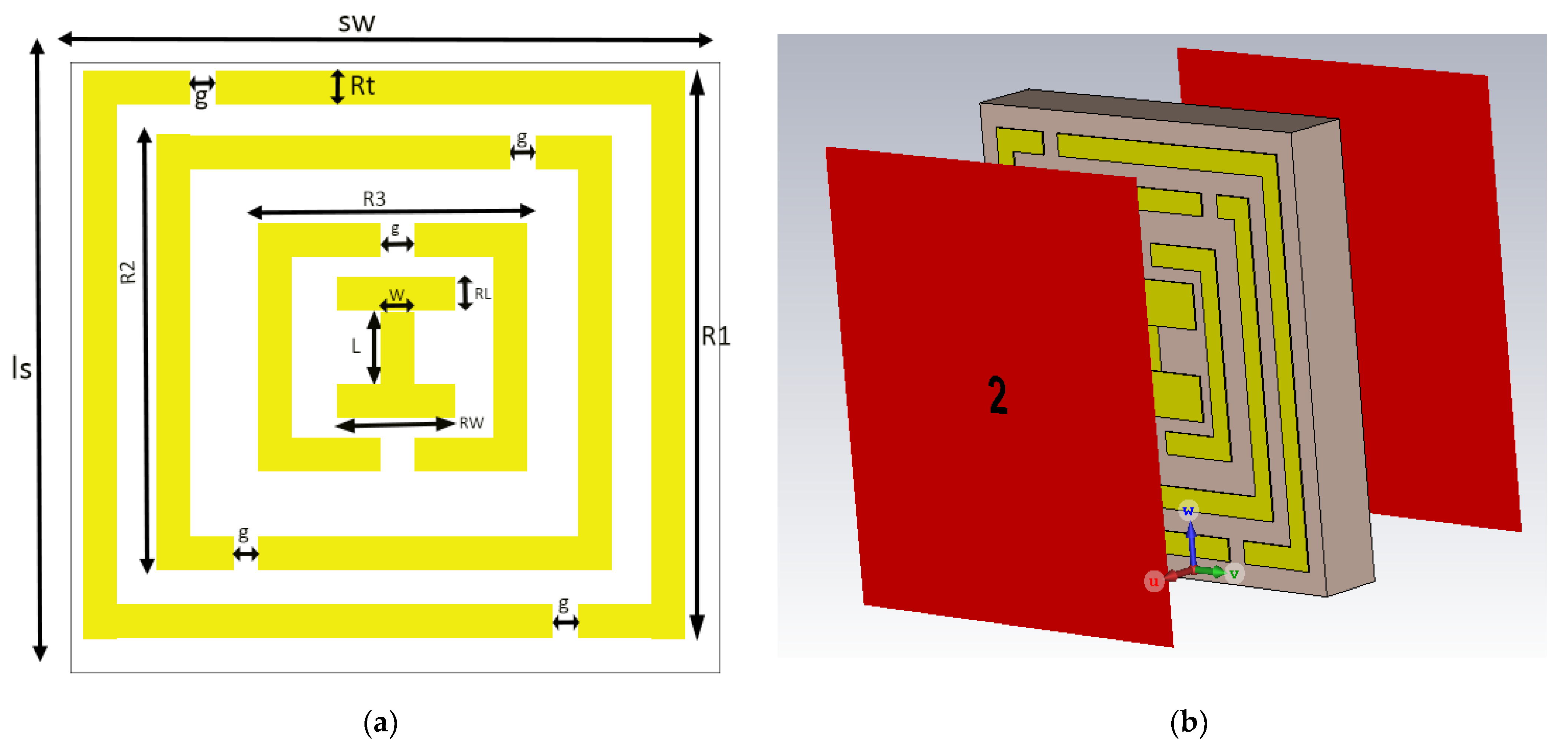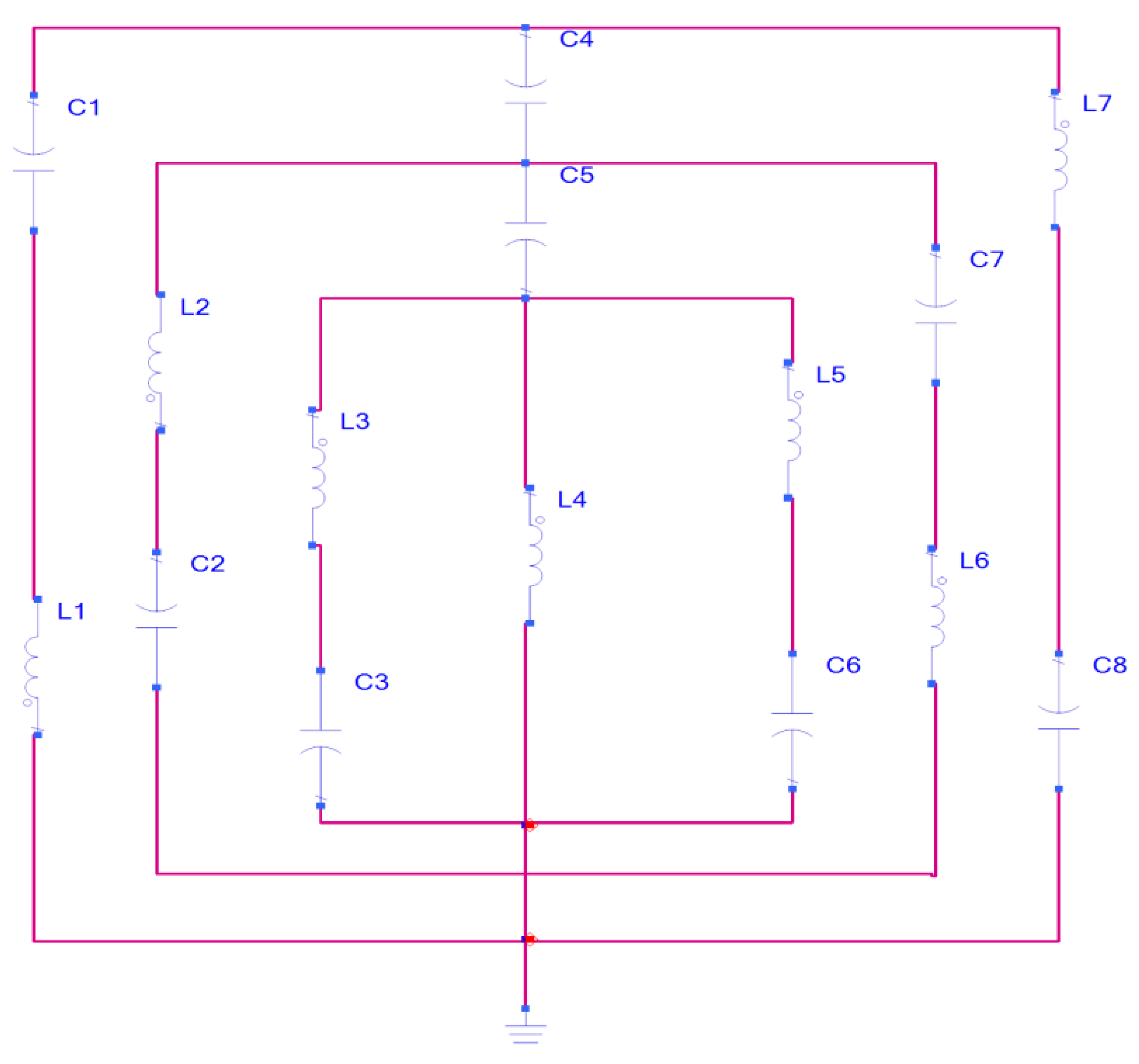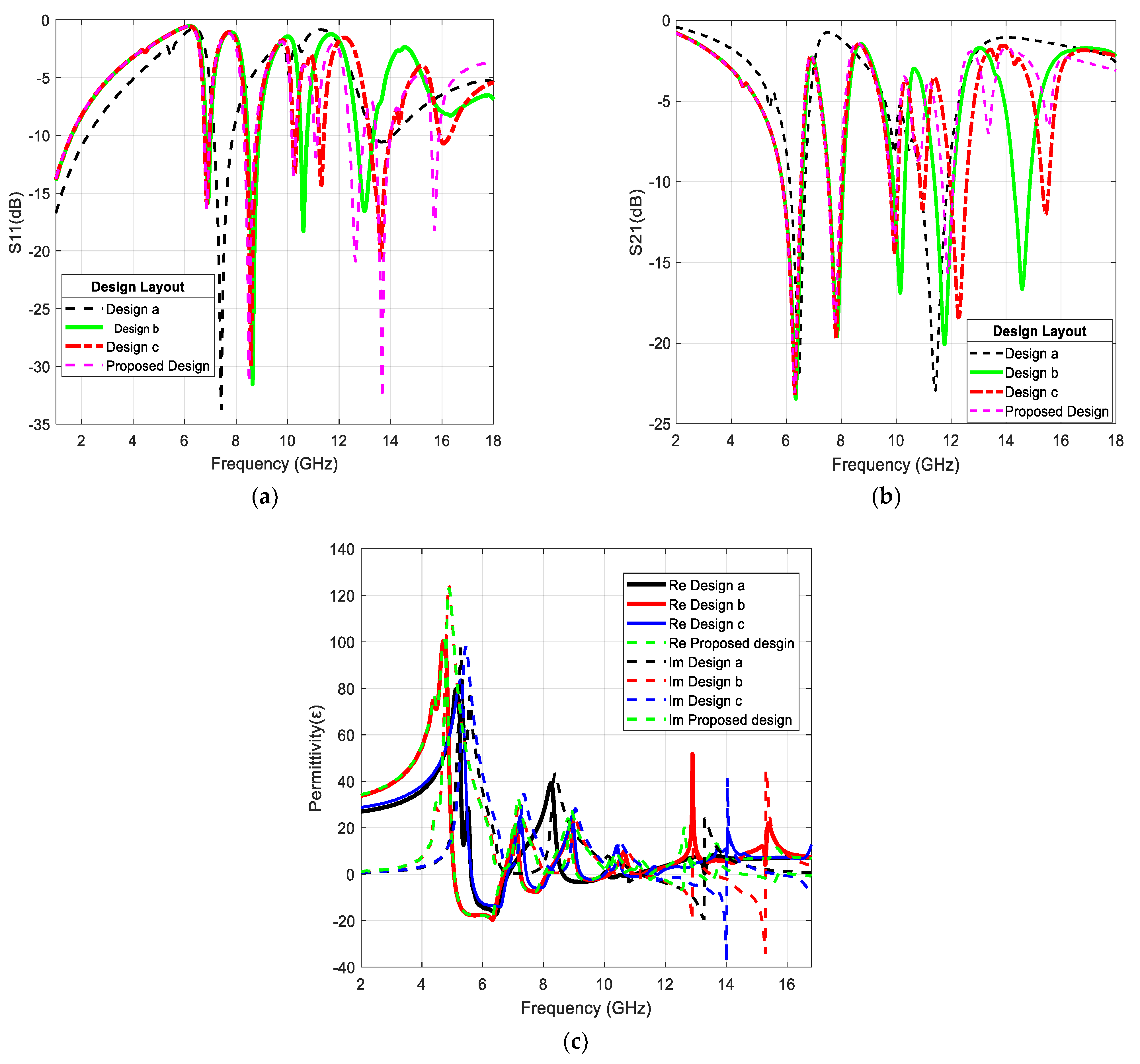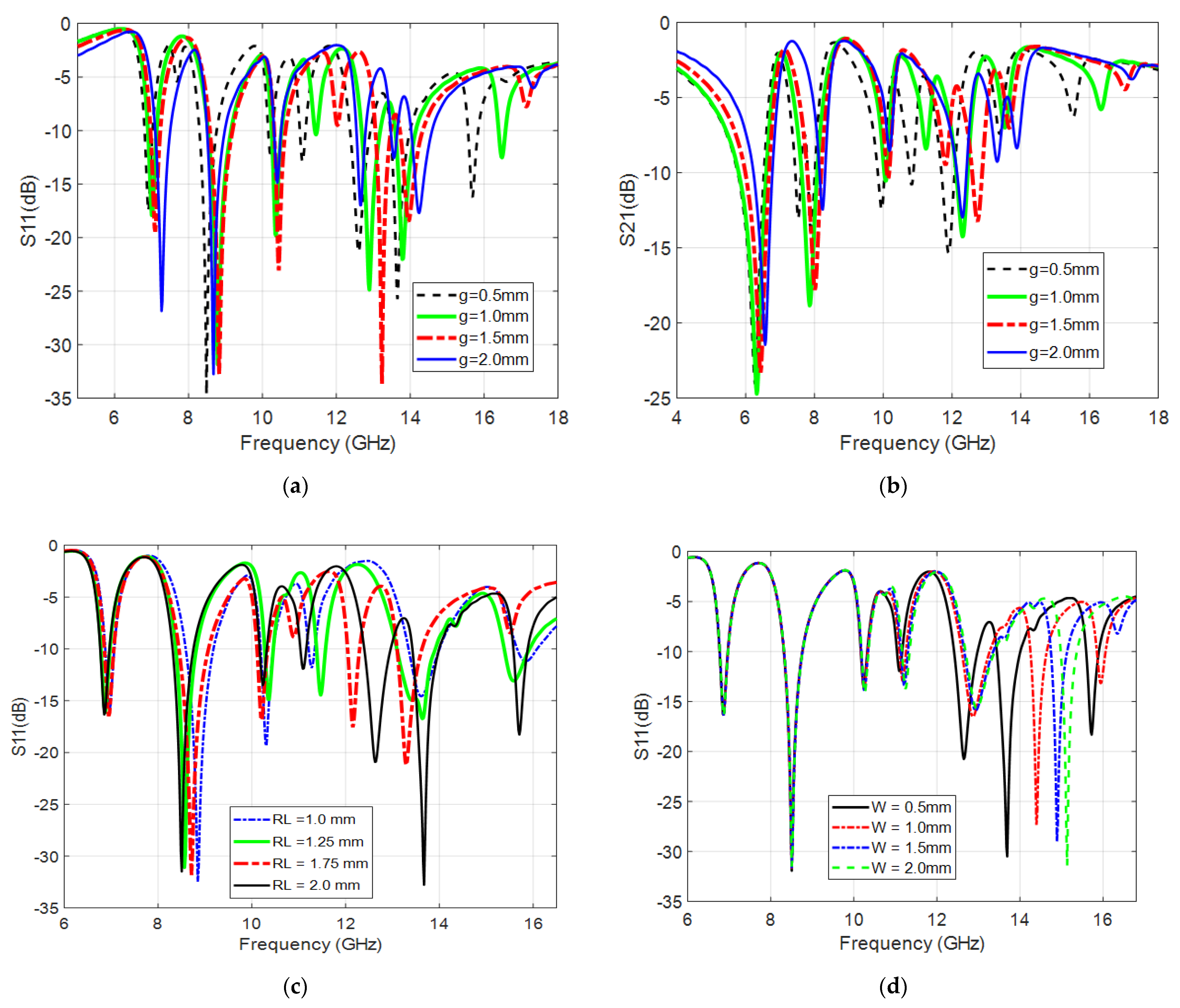I-Shaped Metamaterial Using SRR for Multi-Band Wireless Communication
Abstract
:1. Introduction
2. MeTM Unit Cell Geometry and Design
3. Theoretical Model and Equivalent Circuit of the ISMeTM
4. Design Methodology
5. Methodology for Extracting the Unit Cell’s Effective Medium Parameters
6. ISMeTM Unit Cell Analysis
7. Result and Discussion
8. ISMeTM Array Analysis
9. Conclusions
Author Contributions
Funding
Institutional Review Board Statement
Informed Consent Statement
Data Availability Statement
Conflicts of Interest
References
- Ali, T.; Subhash, B.K.; Pathan, S.; Biradar, R.C. A compact decogonal-shaped UWB monopole planar antenna with truncated ground plane. Microw. Opt. Technol. Lett. 2018, 30, 2937–2944. [Google Scholar] [CrossRef]
- Mandel’shtam, L.I. Group velocity in crystal lattice. Zh. Eksp. Teor. Fiz. 1945, 15, 475–478. [Google Scholar]
- Veselago, V.G. The electrodynamics of substances with simultaneously negative values of ε and µ. Sov. Phy. Usp. 1968, 10, 509–514. [Google Scholar] [CrossRef]
- Pendry, J.B.; Holden, A.J.; Stewart, W.J.; Youngs, I. Extremely low frequency plasmons in metallic meostructure. Phys. Rev. Lett. 1996, 76, 4773. [Google Scholar] [CrossRef] [Green Version]
- Pendry, J.B.; Holden, A.J.; Robbins, D.J.; Stewart, W.J. Magnetism from conductors and enhanced nonlinear phenomena. IEEE Trans. Microw. Theory. Tech. 1999, 47, 2075–2084. [Google Scholar] [CrossRef] [Green Version]
- Smith, D.R.; Willie, W.J.; Vier, D.C.; Nemat-Nasser, S.C.; Schultz, S. Composite medium with simultaneously negative permeability and permittivity. Phy. Rev. Lett. 2000, 84, 4184. [Google Scholar] [CrossRef] [Green Version]
- Iyer, A.K.; Eleftheriades, G.V. Negative refractive index metamaterials supporting 2-D waves. IEEE MTT-S Int. Microw. Symp. Digest. 2002, 2, 1067–1070. [Google Scholar]
- Caloz, C.; Itoh, T. Transmission line approach of left-handed (LH) material and microstrip implementation of an artificial LH transmission line. IEEE Trans. Antennas Propag. 2004, 52, 1159–1166. [Google Scholar] [CrossRef]
- Sreekanth, K.V.; ElKabbash, M.; Alapan, Y.; Rasheed, A.R.; Gurkan, U.A.; Strangi, G. A multiband perfect absorber based on hyperbolic metamaterials. Sci. Rep. 2016, 6, 1–8. [Google Scholar]
- Huang, C.; Zhang, J.; Cheng, Q.; Cui, T. Multi-band tunable asymmetric transmission of linearly polarized electromagnetic waves achieved by active chiral metamaterial. In Proceedings of the 2019 Photonics & Electromagnetics Research Symposium-Fall (PIERS-Fall), Xiamen, China, 17–20 December 2019. [Google Scholar]
- Wang, M.; Yang, Z.; Wu, J.; Bao, J.; Lui, J.; Cai, L.; Dang, T.; Zheng, H.; Li, E. Investigation of SAR reduction using flexible antenna with metamaterial structure in wireless body area network. IEEE Trans Antenna Propag. 2018, 66, 3076–3086. [Google Scholar] [CrossRef]
- Ameen, M.; Chaudhary, R.K. Metamaterial-based circularly polarized antenna employing ENG-TL with enhanced bandwidth for WLAN applications. Electro. Lett. 2018, 54, 1152–1154. [Google Scholar] [CrossRef]
- David, R.M.; Aw, M.S.; Ali, T.; Kumar, P. A multiband antenna stacked with novel metamaterial SCSRR and CSSRR for WiMAX/WLAN applications. Micromachines 2021, 12, 113. [Google Scholar] [CrossRef] [PubMed]
- Srinivasan, K.; Ali, N.B.; Trabelsi, Y.; Mani Rajan, M.S.; Kanzari, M.M. Design of a modified single-negative metamaterial structure for sensing application. Optik 2019, 180, 924–993. [Google Scholar] [CrossRef]
- Chen, H.; Chen, Z.; Yang, H.; Wen, L.; Yi, Z.; Zhou, Z.; Dai, B.; Zhang, J.; Wu, X.; Wu, P. Multi-mode surface plasmon resonance absorber based on dart-type single- layer graphene. RSC Adv. 2022, 12, 7821–7829. [Google Scholar] [CrossRef]
- Hasan, M.M.; Faruque, M.R.I.; Islam, M.T. Dual band metamaterial antenna for LTE/Bluetooth/WIMAX system. Sci. Rep. 2018, 8, 1–17. [Google Scholar] [CrossRef] [PubMed] [Green Version]
- Islam, S.S.; Faruque, M.R.I.; Islam, M.T. An object independent ENZ metamaterial based wideband electromagnetic cloak. Sci. Rep. 2016, 6, 1–10. [Google Scholar] [CrossRef] [Green Version]
- Alex-Amor, A.; Palomares-Caballero, A.; Molero, C. 3-D metamaterials: Trends on applied designs, computational methods and fabrication techniques. Electronics 2022, 11, 410. [Google Scholar] [CrossRef]
- Alam, J.; Faruque, M.R.I.; Islam, M.T. Labyrinth double split open loop resonator based bandpass filter design for S, C and X-band application. J. Phys. D. App. Phys. 2018, 51, 265102. [Google Scholar] [CrossRef]
- Zheng, Z.; Zheng, Y.; Luo, Y.; Yi, Z.; Zhang, J.; Liu, Z.; Yang, W.; Yu, Y.; Wu, X.; Wu, P. A switchable terahertz device combining ultra-wideband absorption and ultra-wideband complete reflection. Phys. Chem. Chem. Phys. 2022, 24, 2527–2533. [Google Scholar] [CrossRef]
- Vendik, I.B.; Vendik, O.G. Metamaterial and their application in microwaves: A review. Tech. Phys. 2013, 58, 1–24. [Google Scholar] [CrossRef]
- Benosman, H.; Hacene, N.B. Design and Simulation of Double “S” Shaped Metamaterial. Int. J. Compt. Sci. Iss. 2012, 9, 1694–1814. [Google Scholar]
- Aznabet, M.; El Mrabet, O.; Floc’h, J.M.; Falcone, F.; Drissi, M.A. A coplanar waveguide-fed printed antenna with complementary split ring resonator for wireless communication systems. Waves. Rand. Comp. Media. 2015, 25, 43–51. [Google Scholar] [CrossRef]
- Mallik, A.; Kundu, S.; Goni, M.O. Design of a novel two-rectangular U-shaped negative metamaterial. In Proceedings of the International Conference on Informatics, Electronics and Vision IEEE, Dhaka, Bangladesh, 17 May 2013. [Google Scholar]
- Alam, M.J.; Ahamed, E.; Faruque, M.R.I.M.; Hossain, J.; Islam, M.T. Aztec shape metamaterial-based bandpass filter for C, X and Ku-band applications. IOP Conf. Ser. Ear. Enviro. Sci. 2019, 228, 012019. [Google Scholar] [CrossRef]
- Ekmekci, E.; Sayan, G.T. Investigation of effective permittivity and permeability for a novel V-shaped metamaterial using S-parameters. In Proceedings of the 5th International Conference on Electrical and Electronics Engineering, Bursa, Turkey, 5–9 December 2007. [Google Scholar]
- Jain, P.; Thourwal, A.; Sardana, N.; Kumar, S.; Gupta, N.; Singh, A.K. I-shaped metamaterial antenna for X-band applications. In Proceedings of the Progress in Electromagnetics Research Symposium-Spring (PIERS), Petersburg, Russia, 22 May 2017. [Google Scholar]
- Dhouibi, A.; Burokur, S.N.; Lustrac, A.; Priou, A. Study and analysis of an electric Z-shaped meta-atom. Advan. Electromag. 2012, 1, 64–70. [Google Scholar] [CrossRef] [Green Version]
- Tamim, A.M.; Faruque, M.R.I.; Alam, M.J.; Islam, S.S.; Islam, M.T. Split ring resonator loaded horizontally inverse double L-shaped metamaterial for C-, X- and Ku-Band Microwave applications. Res. Phys. 2019, 12, 2112–2122. [Google Scholar] [CrossRef]
- Hossain, M.J.; Faruque, A.M.I.; Islam, M.T.; Islam, S.S. An effective medium ratio obeying meta-atom for multiband applications. Bull. Pol. Acad. Sci. Tech. Sci. 2019, 65, 2112–2122. [Google Scholar] [CrossRef] [Green Version]
- Islam, S.S.; Faruque, M.R.I.; Islam, M.T. The design and analysis of a novel H-shaped metamaterial for multi-band microwave applications. Materials 2014, 7, 4994–5011. [Google Scholar] [CrossRef] [Green Version]
- Siddiky, A.M.; Faruque, M.R.I.; Islam, M.T.; Abdullah, S.; Khandaker, M.U. Inverse double-C shaped square split ring resonator-based metamaterial with multi-resonant frequencies for satellite band applications. Res. Phys. 2020, 19, 103454. [Google Scholar]
- Sydoruk, O.; Tatartschuk, E.; Shamonia, E.; Solymar, L. Analytical formulation for the resonant frequency of split rings. J. Appl. Phys. 2009, 5, 014903. [Google Scholar] [CrossRef]
- Rinard, G.A.; Eaton, G.R. Biomedical EPR-Part B: Methodology, Instrumentation, and Dynamics; Springer Science & Business Media: New York, NY, USA, 2005; pp. 19–52. [Google Scholar]
- Grover, F.W. Inductance Calculations: Working Formulas and Tables; Courier Corporation, Instrument Society of America, Research Triangle Park: Pittsburgh, PA, USA, 1981. [Google Scholar]
- Shatz, L.F.; Christensen, C.W. Numerical inductance calculations based on its principles. PLoS ONE 2014, 11, e111643. [Google Scholar]
- Chen, X.; Grzegorczyk, T.M.; Pacheco, B.; Wu, J.; Kong, J.A. Robust method to retrieve the constitutive effective parameters of metamaterials. Phys. Rev. E 2014, 70, 1–7. [Google Scholar] [CrossRef] [PubMed] [Green Version]
- Rothwell, E.J.; Frasch, J.L.; Ellison, S.M.; Chahal, P.; Ouedraogo, R.O. Analysis of the Nicolson-Ross-Weir method for characterizing the electromagnetic properties of engineered materials. Prog. Electromag. Res. 2016, 157, 32–47. [Google Scholar] [CrossRef] [Green Version]
- Gric, T.; Nickelson, L.; Asmontas, S. Electrodynamical characteristic particularity of open metamaterial square and circular waveguides. Prog. Electromag. Res. 2010, 109, 361–379. [Google Scholar] [CrossRef] [Green Version]
- Luukkonen, O.; Maslovski, S.I.; Tretyakov, S.A. A stepwise Nicolson-Ross-Wier-based material parameter extraction method. IEEE Ant. Wirel. Propag. Lett. 2011, 10, 1295–1298. [Google Scholar] [CrossRef]
- Afsar, S.U.; Faruque, M.R.I.; Hossain, M.J.; Khandaker, M.U.; Osman, H.; Alamri, S. Modified Hexagonal split ring resonator based on epsilion-negative metamaterial for triple-band satellite communication. Micromachines 2021, 12, 878. [Google Scholar] [CrossRef]
- Moniruzzaman, M.; Islam, M.T.; Islam, M.R.; Misran, N.; Samsuzzaman, M. Coupled ring split resonator (CR-SRR) based epsilon negative metamaterial for multiband wireless communications with high effective medium ratio. Res. Phys. 2020, 18, 103248. [Google Scholar] [CrossRef]









| Parameter | Dimension (mm) | Parameter | Dimension (mm) |
|---|---|---|---|
| sw | 10 | Rw | 1.25 |
| ls | 10 | L | 1 |
| R1 | 9 | W | 0.5 |
| R2 | 4 | g | 0.5 |
| R3 | 2.8 | sh | 1.6 |
| Rt | 0.5 | ch | 0.035 |
| Rl | 2 | tw | 0.5 |
| Design Layout | Frequency (GHz) | S21 (dB) |
|---|---|---|
| Design a | 6.4, 10.02, 11.82 | −21.99, −8.23, −22.96 |
| Design b | 6.23, 7.81, 10.17, 11.98, 14.68 | −23.12, −19.53, −16.81, −19.97, −16.41 |
| Design c | 6.32, 7.81, 9.98, 11.46, 12.21, 15.67 | −18.15, −16.14, −11.75, −7.34, −19.13, 8.32 |
| Proposed design (ISMeTM) | 6.31, 7.79, 9.98, 10.82, 11.86, 13.36, 15.5 | −22.96, −18.89, −13.47, −8.64, −15.49, −6.87, −6.45 |
| Configuration | SNG Freq. Range (GHz) | S21 Dips Frequencies (GHz) | S21 (dB) |
|---|---|---|---|
| ISMeTM unit cell | 5.46–6.29, 11.6–11.8, 13.8–15,15.8–16.8 | 6.31, 7.79, 9.98, 10.82, 11.86, 13.36, 15.5 | −22.96, −18.89, −13.47, −8.64, −15.49, −6.87, −6.45 |
| ISMeTM 1 × 2 array | 5.46–6.29, 11.35–11.44, 13.2–14.9, 15.8–16.4 | 6.23, 7.76, 10.10, 10.78, 11.72, 13.36, 15.5 | −22.40, −17.91, −11.64, −9.84, −17.16, −4.56, −6.35 |
| ISMeTM 2 × 2 array | 5.44–6.31, 13.3–13.9, 14.6–15.8, 16.1–16.3 | 4.63, 6.05, 6.64, 7.44, 8.12, 10.4 | −8.33, −18.46, −13.97, −14.67, −14.04, −14.21 |
| ISMeTM 2 × 4 array | 5.46–6.28, 13.6–14.2, 14.9–15.3, 15.9–16.4 | 4.69, 5.96, 6.52, 7.30 7.84, 8.20, 10.52 | −8.67, −13.57, −17.35, −12.33, −16.41, −16.49, −16.76 |
| Ref | Dimension (mm)2 | Shape | Substrate | Band | Resonance Frequency (GHz) |
|---|---|---|---|---|---|
| [22] | 4 × 4 | Double S | FR-4 | Ku- | 1 |
| [23] | 30 × 22 × 0.8 | CSRR | Roger Duroid TM 5880 | C | 1 |
| [24] | 25 × 25 × 1 | U-shaped | Glass | C | 1 |
| [25] | 12 × 11 × 1.6 | Aztec | FR-4 | C, X, Ku | 4 |
| [26] | 5 × 5 × 0.25 | V-shaped | Fused Quartz | X | 1 |
| [27] | 12.5 × 12.5 | I-shaped | FR-4 | X | 1 |
| [28] | 10 × 10 | Inverse double L | Rogers RT 5880 | C, X, Ku | 4 |
| [30] | 12 × 12 × 1.635 | C-shaped | Rogers RT 6010 | S, C, X, Ku | 4 |
| [31] | 30 × 30 | H-shaped | FR-4 | S, C, X, Ku | 4 |
| [32] | 9 × 9 × 1.6 | Double C | FR-4 | S, C, X, Ku | 5 |
| Proposed | 10 × 10 × 1.6 | I-shaped | FR-4 | C, X, Ku | 7 |
Publisher’s Note: MDPI stays neutral with regard to jurisdictional claims in published maps and institutional affiliations. |
© 2022 by the authors. Licensee MDPI, Basel, Switzerland. This article is an open access article distributed under the terms and conditions of the Creative Commons Attribution (CC BY) license (https://creativecommons.org/licenses/by/4.0/).
Share and Cite
Ajewole, B.; Kumar, P.; Afullo, T. I-Shaped Metamaterial Using SRR for Multi-Band Wireless Communication. Crystals 2022, 12, 559. https://doi.org/10.3390/cryst12040559
Ajewole B, Kumar P, Afullo T. I-Shaped Metamaterial Using SRR for Multi-Band Wireless Communication. Crystals. 2022; 12(4):559. https://doi.org/10.3390/cryst12040559
Chicago/Turabian StyleAjewole, Bukola, Pradeep Kumar, and Thomas Afullo. 2022. "I-Shaped Metamaterial Using SRR for Multi-Band Wireless Communication" Crystals 12, no. 4: 559. https://doi.org/10.3390/cryst12040559






